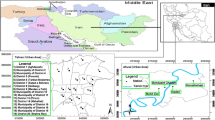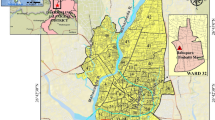Abstract
Meteorological variability plays a pivotal role in ambient air pollution. An in-depth analysis of air pollutants including meteorological variables in four suburbs of greater Sydney, Australia, was carried out for a continuous period of 24 months from January 2016 to 2018. Results revealed significant air quality problems with seasonal trends, for all six pollutants, in all suburbs. Maximum 24-h average PM10 concentrations for the four suburbs were 49.4, 55.3, 74.0 and 102.8 μg/m3 demonstrating severe PM10 air pollution events. NO2 concentrations exceeded national guideline limits and all four suburbs showed higher than recommended concentrations of O3. Generalised additive model analysis displayed varying dependencies between air pollutants and meteorological variables influenced by season and location. Different plots were used to interpret data in terms of meteorological variables. Generally, easterly and southerly winds led to the highest average concentrations of air pollutants for all suburbs. Extremes in air quality pollution concentrations were related to east and west winds and higher wind speeds (4–8 m/s). Wide variations existed in air pollutants between the 10th and 95th percentile values, especially PM10. Minimum and maximum concentration of all analysed pollutants occurred during low temperatures (11.7–18.4 °C) with the exception of ozone favouring higher temperatures (24–38 °C) during hotter months. Results show pollution formation varies in different seasons and suburbs, in relation to meteorological variables. This study can be used to mitigate, improve prediction and forecast accuracy of air pollution. Such studies open the possibilities to explore the effects of air quality and its impact on public health.






Similar content being viewed by others
References
Azmi SZ, Latif MT, Ismail AS, Juneng L, Jemain AA (2010) Trend and status of air quality at three different monitoring stations in the Klang Valley, Malaysia. Air Qual Atmos Health 3(1):53–64
Begum BA, Biswas SK, Hopke PK, Cohen DD (2006) Multi-element analysis and characterization of atmospheric particulate pollution in Dhaka. Aerosol Air Qual Res 6(4):334–359
Cao C, Zheng S, Singh RP (2014) Characteristics of aerosol optical properties and meteorological parameters during three major dust events (2005–2010) over Beijing, China. Atmos Res 150:129–142
Carslaw DC, Ropkins K (2012) Openair—an R package for air quality data analysis. Environ Model Softw 27:52–61
Gong J, Hu Y, Liu M, Bu R, Chang Y, Li C, Wu W (2015) Characterization of Air Pollution Index and Its Affecting Factors in Industrial Urban Areas in Northeastern China. Pol J Environ 24:4
Han S, Bian H, Feng Y, Liu A, Li X, Zeng F, Zhang X (2011) Analysis of the relationship between O3, NO and NO2 in Tianjin, China. Aerosol Air Qual Res 11(2):128–139
Han L, Zhou W, Li W, Meshesha DT, Li L, Zheng M (2015) Meteorological and urban landscape factors on severe air pollution in Beijing. J Air Waste Manage Assoc 65(7):782–787
Islam MM, Afrin S, Ahmed T, Ali MA (2015) Meteorological and seasonal influences in ambient air quality parameters of Dhaka city. J Civ Eng 43(1):67–77
Jacob DJ, Winner DA (2009) Effect of climate change on air quality. Atmos Environ 43(1):51–63
Ji H, Wang QG, Yu Y, Lu Y, Qian X (2019) How have the characteristics of air quality in a typical large Chinese city changed between 2011 and 2017? Air Qual Atmos Health 12(4):401–410
Kayes I, Shahriar SA, Hasan K, Akhter M, Kabir MM, Salam MA (2019) The relationships between meteorological parameters and air pollutants in an urban environment. Glob J Environ Sci Manag 5(3):265–278
Li J, Yang W, Wang Z, Chen H, Hu B, Li J, Sun Y, Huang Y (2014) A modeling study of source–receptor relationships in atmospheric particulate matter over Northeast Asia. Atmos Environ 91:40–51
Manju A, Kalaiselvi K, Dhananjayan V, Palanivel M, Banupriya GS, Vidhya MH, Panjakumar K, Ravichandran B (2018) Spatio-seasonal variation in ambient air pollutants and influence of meteorological factors in Coimbatore, Southern India. Air Qual Atmos Health 11(10):1179–1189
Megaritis AG, Fountoukis C, Charalampidis PE, Denier Van Der Gon HAC, Pilinis C, Pandis SN (2014) Linking climate and air quality over Europe: effects of meteorology on PM 2.5 concentrations. Atmos Chem Phys 14(18):10283–10298
Miao Y, Guo J, Liu S, Liu H, Zhang G, Yan Y, He J (2017) Relay transport of aerosols to Beijing-Tianjin-Hebei region by multi-scale atmospheric circulations. Atmos Environ 165:35–45
New South Wales Department of Planning, Industry and Environment (NSWDPEI) – Office of Environment and Heritage (OEH), Monitoring air quality (2019) https://www.environment.nsw.gov.au/topics/air/monitoring-air-quality
Pearce JL, Beringer J, Nicholls N, Hyndman RJ, Tapper NJ (2011) Quantifying the influence of local meteorology on air quality using generalized additive models. Atmos Environ 45(6):1328–1336
Pirhadi M, Mousavi A, Taghvaee S, Shafer MM, Sioutas C (2020) Semi-volatile components of PM2. 5 in an urban environment: volatility profiles and associated oxidative potential. Atmos Environ 117197:223
R Development Core Team R.F.F.S.C (2011) R: a language and environment for statistical computing
Ran L, Zhao C, Geng F, Tie X, Tang X, Peng L, Zhou G, Yu Q, Xu J, Guenther A (2009) Ozone photochemical production in urban Shanghai, China: analysis based on ground level observations. J Geophys Res Atmos 114(D15)
Rashki A, Rautenbach CD, Eriksson PG, Kaskaoutis DG, Gupta P (2013) Temporal changes of particulate concentration in the ambient air over the city of Zahedan, Iran. Air Qual Atmos Health 6(1):123–135
Ravindra K, Rattan P, Mor S, Aggarwal AN (2019) Generalized additive models: building evidence of air pollution, climate change and human health. Environ Int 132:104987
Thompson ML, Reynolds J, Cox LH, Guttorp P, Sampson PD (2001) A review of statistical methods for the meteorological adjustment of tropospheric ozone. Atmos Environ 35(3):617–630
Tian G, Qiao Z, Xu X (2014) Characteristics of particulate matter (PM10) and its relationship with meteorological factors during 2001-2012 in Beijing. Environ Pollut 192:266–274
Tu J, Xia ZG, Wang H, Li W (2007) Temporal variations in surface ozone and its precursors and meteorological effects at an urban site in China. Atmos Res 85(3-4):310–337
Wood SN (2006) Generalized additive models: an introduction with R. Chapman and Hall/CRC Press, London
Yuan Q, Yang L, Dong C, Yan C, Meng C, Sui X, Wang W (2014) Particle physical characterization in the Yellow River Delta of Eastern China: number size distribution and new particle formation. https://doi.org/10.1007/s11869-014-0293-4
Zhang H, Wang Y, Hu J, Ying Q, Hu XM (2015) Relationships between meteorological parameters and criteria air pollutants in three megacities in China. Environ Res 140:242–254
Zu Y, Huang L, Hu J, Zhao Z, Liu H, Zhang H, Ying Q, Chen M (2017) Investigation of relationships between meteorological conditions and high PM 10 pollution in a megacity in the western Yangtze River Delta, China. Air Qual Atmos Health 10(6):713–724
Acknowledgements
The authors would like to express their thanks to the Editor and two anonymous reviewers whose comments have helped to improve the paper notably.
Author information
Authors and Affiliations
Corresponding author
Ethics declarations
Competing interests
The authors declare that they have no conflict of interest.
Additional information
Publisher’s note
Springer Nature remains neutral with regard to jurisdictional claims in published maps and institutional affiliations.
Highlights
• Assess impacts of meteorological variables on air quality pollutants
• Assessed temporal variations of air pollutants and meteorological variables
• GAMs used to assess dependency of air pollutants on meteorological variables
• Extremes of pollutants were assessed in relation to 10th and 95th percentiles
• Air pollutant min and max were assessed by trend level and percentile rose plots
Electronic supplementary material
ESM 1
(DOCX 3668 kb)
Rights and permissions
About this article
Cite this article
Haddad, K., Vizakos, N. Air quality pollutants and their relationship with meteorological variables in four suburbs of Greater Sydney, Australia. Air Qual Atmos Health 14, 55–67 (2021). https://doi.org/10.1007/s11869-020-00913-8
Received:
Accepted:
Published:
Issue Date:
DOI: https://doi.org/10.1007/s11869-020-00913-8




